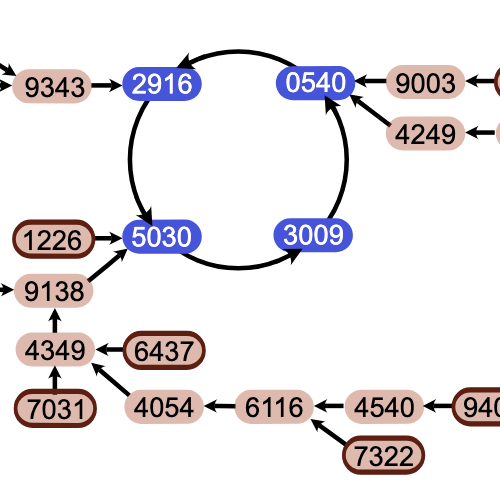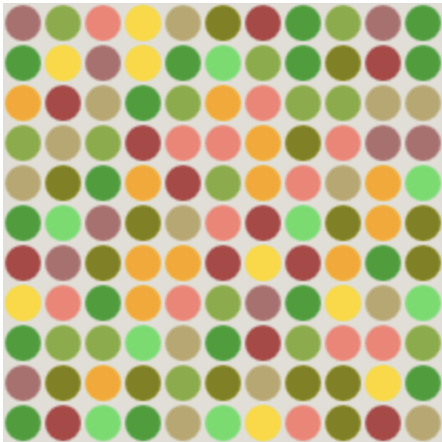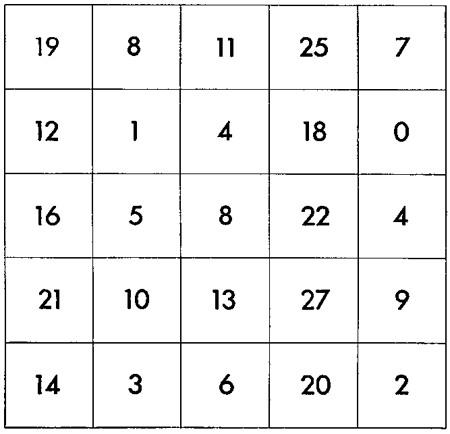Truth, Trump, and Trisectors
by Brian Hayes
Published 15 December 2016
What is truth? said jesting Pilate, and did not stay for an answer.
Lately there’s been a lot of news about fake news (some of it, for all I know, fake). Critics are urging Facebook, Google, and Twitter to filter out the fraudulent nonsense. This seems like a fine idea, but it presupposes that the employees—or algorithms—doing the filtering can reliably distinguish fact from fiction. Even if they can tell the difference, can we count on the companies to stand up to the prevaricators? Sure, Facebook can block traffic from a clickbait website run by a teenager in Macedonia. But what if the lies were to come from an account registered in the .gov domain?
When misinformation is stamped with the imprimatur of the president or other high government officials, there’s not much hope of shutting it down at the source or breaking the chain of transmission. This problem was not created by the new communication technologies of the internet age, and it is not unique to the incoming Trump administration. I have probably been lied to by every president who has served during my lifetime, and I could name seven of those presidents whose fibs are well documented. But Trump is different. He is not a devious liar, careful not to be caught in a contradiction. He is simply indifferent to truth. When challenged to support a dubious claim, he shrugs or changes the subject. The question of veracity seems not to interest him. And his election suggests that some part of the voting public feels the same way.
What to do? The only practical remedy I can suggest is to work diligently to uncover the truth, to publish it widely, and to help the public reach sound judgments about what to believe. All three of these tasks are difficult, but the last one, in my view, is the real stumper. As the signal-to-noise ratio in public discourse dives toward zero, we would all do well to sharpen our powers of discrimination. But I worry most about that subpopulation for whom strict factual accuracy is not the primary criterion when they choose stories to pass on to their friends and to embrace as the basis of important decisions. I don’t know how to change this, but I feel it’s important to try.
I’d like to begin with a more personal and less political anecdote. Some years ago, when the internet was young, a friend began sending me emails with subject lines like “Save 7 y.o. Jessica Mydek from cancer” or “Fw: Fw: FW: Fw: Bill No. 602P 5-cent tax on every email.” I would reply with a link to the debunking report at Snopes. My friend would thank me and sheepishly apologize, then the next month she would forward a message warning me not to blink my high beams if I saw a car with the headlights off—I’d be attacked by gang members conducting a rite of initiation. Email exchanges like these continued for a year or so, then they tapered off. Had my friend developed a measure of skepticism? Yes, but not in the way I had hoped. She had become skeptical of snopes.com. After all, it’s a website with a funny name, run by smug, self-appointed know-it-alls who make fun of gullible people. Why should she trust them?
Instead of an ad hoc watchdog like Snopes, maybe we should have an official arbiter of factuality, a certified and sanctified public agency. Call it the Ministry of Truth. And let’s give it enforcement powers: No social network or news outlet is allowed to publish anything unless the ministry attests to its accuracy.
Okay, that’s not such a hot idea after all.
In any case, no amount of scrupulous fact-checking would have cured my friend’s addiction to hoax email. There was something in those messages she wanted to believe. Even if 7 y.o. Jessica Mydek doesn’t exist, a world where chain letters can cure cancer is more appealing and empowering than the Snopesian world of grim facts, where you can only watch helplessly while a child dies. When you see a car driving without headlights, it’s more exciting to imagine a murderer at the wheel than a forgetful old fool. I’m sure my friend had her own doubts about some of these breathless pleas and warnings, but she was willing to overlook dodgy evidence or flawed logic for the sake of a good story.
As far as I know, my friend’s lax attitude toward factuality never caused grievous harm to herself or anyone else. But sometimes credulity can be disastrous.
Those who can make you believe absurdities can make you commit atrocities.
—Voltaire (paraphrase)
Let’s talk about Edgar Maddison Welch, the young man who showed up at the Comet Ping Pong pizzeria with a rifle and a handgun. By his own account, he sincerely believed he was going to rescue children being held captive in a basement room and subjected to unspeakable acts by Hillary Clinton and her associates. Where did that idea come from? Apparently it began with leaked emails from the hacked account of John Podesta, Clinton’s campaign chairman. According to an outline in the New York Times, eager sleuths on Reddit and 4chan discovered the phrase “cheese pizza” in the email texts, and recognized it as a code word for “child pornography.” Connecting the rest of the dots was easy and obvious: Podesta had corresponded with the owner of Comet Ping Pong, and Barack Obama had been photographed playing ping pong with a small boy, and so the basement of the restaurant must be where the Democrats slaughter their child sex slaves. However, the would-be rescuer with the AR-15 found no basement kill room—in fact, no basement at all. “The intel on this wasn’t 100 percent,” he told a Times reporter.
In case there’s even the slightest doubt, let me say plainly that I don’t believe a word of that grotesque tale about child abuse in the pizza parlor. Indeed, I can make sense of it only as a stupid joke, a parody, a deliberately preposterous confection. If I were fabricating such a malicious fiction, and if I wanted people to believe it, I would come up with something that’s not such a total affront to plausibility. Yet at least one reader of these fantasies took them in deadly earnest. We’ll never know how many more believe there might be a “grain of truth” in the story, even if specific details are wrong. And the purveyors of the myth are not backing down. In an AP story that ran in the Times on December 9 they propose that the Comet Ping Ping event was a “false flag,” yet another twist in the larger plot:
James Fetzer, a longtime conspiracy theorist who also believes the Sandy Hook school shooting was a hoax, told The Associated Press that Welch’s visit to the pizzeria was staged to distract the public from the truth of the “pizzagate” allegations. . . .
Fetzer and other conspiracy theorists seized on the fact that Welch had dabbled in movie acting as a giveaway that his visit to the restaurant was staged. . . . Blogger Joachim Hagopian, a false-flag proponent, told the AP that conspirators look for “a patsy or stooge” to pose as a lone gunman with an assault rifle. Welch, he said, “fits the pattern” with his acting background.
“He’s got an IMDB (Internet Movie Database) profile,” Hagopian said.
It’s easy to heap ridicule on these ideas. Indeed, by quoting them at length that’s exactly what I’m doing. How could anyone possibly believe in such contrived and convoluted schemes, such teetering towers of improbabilities? But it’s useful to keep in mind that the incredulity goes both ways. The conspiracy theorists would snigger at my naiveté for believing what I read in New York Times. Anyone who’s paying attention knows that all the big papers and TV networks are parties to the conspiracy. (Snopes is surely in on it too.)
Mathematics alone proves, and its proofs are held to be of universal and absolute validity, independent of position, temperature or pressure. You may be a Communist or a Whig or a lapsed Muggletonian, but if you are also a mathematician, you will recognize a correct proof when you see one.
—Philip J. Davis, American Mathematical Monthly, 79(3):254 (March 1972)
A high-stakes presidential election and accusations of child rape and murder certainly add force and immediacy to a discourse on the nature of truth, but they also distract. I would like to retreat from these incendiary themes, at least for a few paragraphs, and look at the calmer universe of mathematics, where we have well-developed mechanisms for distinguishing between truth and falsehood.
Take the case of angle trisectors—people who claim they can divide an arbitrary angle into equal thirds with the standard Euclidean toolkit of straightedge and compass. In some respects, trisectors are like peddlers of pizza parlor pedophilia, but when a trisector comes before you, you can give a stronger response than: “What you claim is contrary to common sense.” You can offer an absolute refutation: “What you claim is impossible. Pierre Laurent Wantzel proved it 180 years ago.” But I wouldn’t count on the trisector meekly accepting this answer and going away.
A few years ago, writing in American Scientist, I made an earnest effort to explain the Wantzel proof in some detail and in plain words, and I provided an English translation of Wantzel’s own paper from 1837. Soon after the article appeared, I began receiving letters festooned with elaborate geometric diagrams, some of them quite pretty, which the authors presented as proper straightedge-and-compass trisections. I wasn’t surprised at this development, but I was at a loss for how to respond. If a mathematical proof fails to persuade the reader of the truth of a mathematical proposition, what other kind of argument could possibly be more effective?
In the past few weeks I’ve given this incident further thought, and I’ve come to see it in a different light. The task of “persuading the reader,” even in mathematics, is not just about truth; it’s also about trust, or rapport, or social solidarity. The quip by Philip Davis that I reproduce above has long been a favorite of mine, but at this point I am tempted to turn it inside out. What I would say is not “If you’re a mathematician, you’ll recognize a proof” but “If you recognize a proof, you’re a mathematician.” The ability and willingness to engage in a certain style of reasoning, and to accept the consequences of that mental process no matter what the outcome, marks you as a member of the mathematical tribe. And, conversely, if you respond to a proof by saying “It may be impossible but I can do it anyway,” then you are not a member of this particular affinity group.
I am not arguing here that mathematical truth is some kind of socially determined quantity, and no more fundamental than religious or political doctrines. Quite the contrary, I am one of those stubborn prepostmodernists who believes in a reality that’s not just my private daydream. I’m convinced we all share one universe, where certain things are true and others aren’t, where certain events happened and others didn’t. The interior angles of a plane triangle will always sum to 180 degrees no matter what I say. Nevertheless, the process by which we recognize such truths and reach consensus about them is a social one, and it’s not infallible.
The same essay in which I discussed Wantzel’s proof also mentioned the infamous Monty Hall problem.
In 1990 Marilyn vos Savant, a columnist for Parade magazine, discussed a hypothetical situation on the television game show “Let’s Make a Deal,” hosted by Monty Hall. A prize is hidden behind one of three doors. When a contestant chooses door 1, Hall opens door 3, showing that the prize is not there, and offers the player the option of switching to door 2. Vos Savant argued . . . that switching improves the odds from 1/3 to 2/3.
In the following weeks thousands of letter writers berated vos Savant for her blatant error, insisting that the two remaining closed doors were equally likely to conceal the prize. Quite a few of those critics identified themselves as mathematicians or mathematics teachers. Even Paul Erdős took this side of the controversy (although he didn’t write a letter to Parade). But of course vos Savant was right all along.
This story was already well known when I told it in my American Scientist essay, but I have a reason for retelling it yet again now. Along with the mail from angle trisectors I also received irate messages from Monty Hall deniers, who insisted that the probabilities really are 1/2 and 1/2. But this time it wasn’t professional mathematicians who raised objections; they had long since resolved their differences and settled on the correct answer. Now it was outsiders, dissidents, who attacked what they perceived to be an ignorant, entrenched orthodoxy enforced by the professoriat. In other words, the same two factions continued to fight over the same question, but they had switched positions.
The point I’m making here is the unsurprising one that social factors influence judgment. We are all predisposed to go along with the views of those we know and trust, and we are skeptical, at least initially, of ideas that come from outsiders. We listen more attentively and sympathetically when the speaker is a trusted colleague. The scrawled manuscript from an unknown author claiming a simple proof of the Riemann hypothesis gets a cursory reading or none at all. There’s nothing wrong with making such distinctions. The alternative—equal treatment for the competent and the crackpot—would certainly not help advance the cause of truth. But it has to be acknowledged that these practices further alienate outsiders. By pushing them away and closing off the channel of communication—treating them as irredeemables and deplorables—we diminish the chance that they will ever find a path into the community.
Why do the nations so furiously rage together, and why do the people imagine a vain thing?
—Psalms, 2:1, via George Frideric Handel
Do these skirmishes over minor mathematical questions have anything to do with “Fakebook” news that might have turned the tide of a presidential election? I submit there is a connection. In both cases the nub of the problem is not discovering the truth but persuading people to recognize and own it. The mathematical examples show that even the most irrefutable kind of evidence—a deductive proof—is not always enough to win over skeptics or opponents.
Proof is said to “compel belief”: You embrace the result even against your will. Once you grant the premises, and you work through the chain of implications, accepting the validity of each step in turn, you have no choice but to accept the ultimate conclusion. Or so one might think. But this view of proof as an irresistible engine of reason underestimates the flexibility and creativity of the human mind. In fact we are all capable of believing impossible things before breakfast, and denying certainties after dinner, if we choose to. Mathematicians—members of the tribe—promise not to do so, but that pledge is not binding on anyone else.
When I look back over my various encounters with angle trisectors and other mathematical mavericks, I can’t recall a single instance where I successfuly persuaded someone to give up an erroneous belief and accept the truth. Not one soul saved. This record of failure does not give me great confidence when I think of venturing forth to combat fake political news, where we don’t even have the secret weapon of deductive proof.
I’m left with the thought that compelling people to acknowledge a truth may be the wrong approach, the wrong attitude. Voltaire was a great hero of free-thinking, but his motto “Écrassez l’infâme!” is a bit too militaristic for my taste. However you choose to translate that phrase, he meant it as a call to arms. Let us crush superstition, wipe out error and ignorance, put an end to fanaticism and irrationality. I’m for all that, but I don’t want to be bludgeoning people into accepting the truth. It doesn’t really change their minds, and at some point they bludgeon you back.
Rather than force the people to give up their false notions and vain things, I would let the truth seduce them. Let them fall in love with it. Doesn’t that sound grand? If only I had the slightest clue about how to make it happen.
I like mathematics largely because it is not human and has nothing particular to do with this planet or with the whole accidental universe—because, like Spinoza’s God, it won’t love us in return.
At this point my only consolation is a cold and severe one. Trump may be indifferent to truth, but the universe, in the long run, is utterly indifferent to him and his foibles. Our new president can declare that climate change is a hoax, and purge government agencies of all those who disagree, but those acts will not lower the concentration of carbon dioxide in the atmosphere.
Mathematical truths are even more aloof from human interference. In Orwell’s 1984 the Thought Police boast of making citizens believe that two plus two equals five. But all the sophistry of the Ministry of Truth and all the torture chambers of the Ministry of Love cannot alter the equation itself. They cannot make two and two equal five.
These are very small islands of certainty in a vast maelstrom of confusion, but they offer refuge, and maybe a place to build from.
Responses from readers:
Please note: The bit-player website is no longer equipped to accept and publish comments from readers, but the author is still eager to hear from you. Send comments, criticism, compliments, or corrections to brian@bit-player.org.
Publication history
First publication: 15 December 2016
Converted to Eleventy framework: 22 April 2025




Yes, the lack of critical thinking skills on display these days is alarming. I too had been thinking about it this week, and my only solution is for the educational system to train young people in General Semantics, logical fallacies, persuasion techniques, and credibility from an early grade. The problem is, even if we started tomorrow, it will take a generation for those ‘immunized’ kids to grow up and be turned loose in the work-a-day world to make a difference. In the meantime, a lot of damage will done by those now in charge. Can’t hide the fact that I’m very pessimistic about the next couple decades.
Hi Brian,
Thanks for a great article on an important topic. BTW, you have a typo: “pubic” instead of “public”.
Paul
Oops! Innocent mistake, honest. Not a comment on the state of the erectorate.
Apropos of Wantzel. You may find this paper of interest:
Jesper Lützen, Why was Wantzel overlooked for a century?, Historia Mathematica 36 (2009) 374-394, doi:10.1016/j.hm.2009.03.001
This is a wonderful essay Brian. Thank you!
Beautifully written, as ever. I was just discussing exactly this over breakfast and will be passing on your article. I am clinging chillily to that cold and severe consolation!